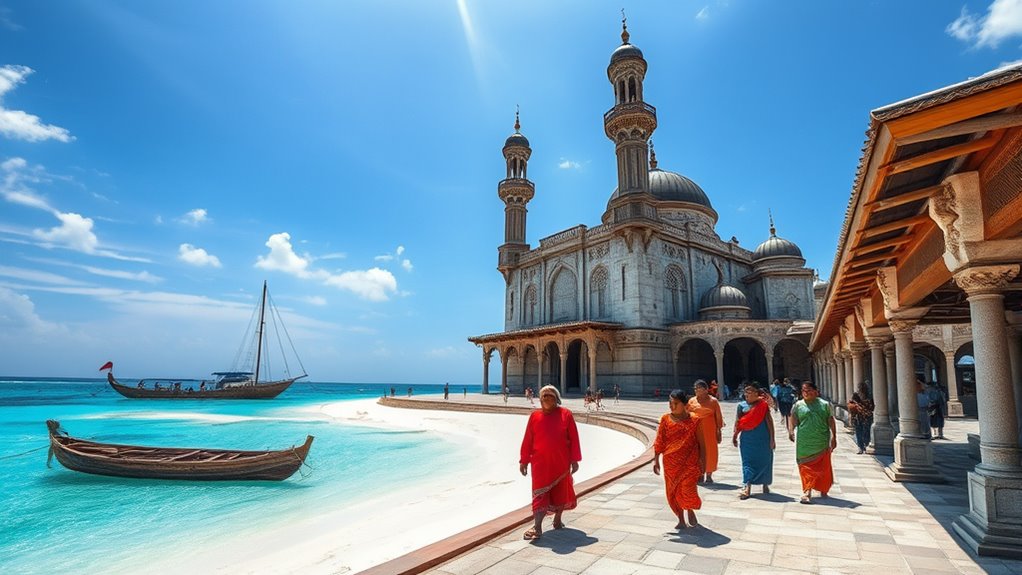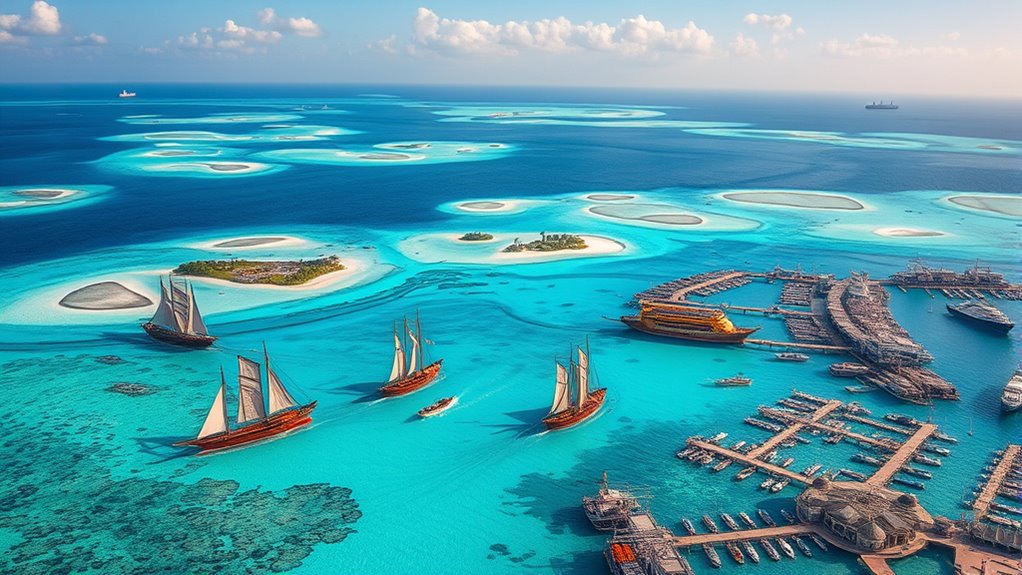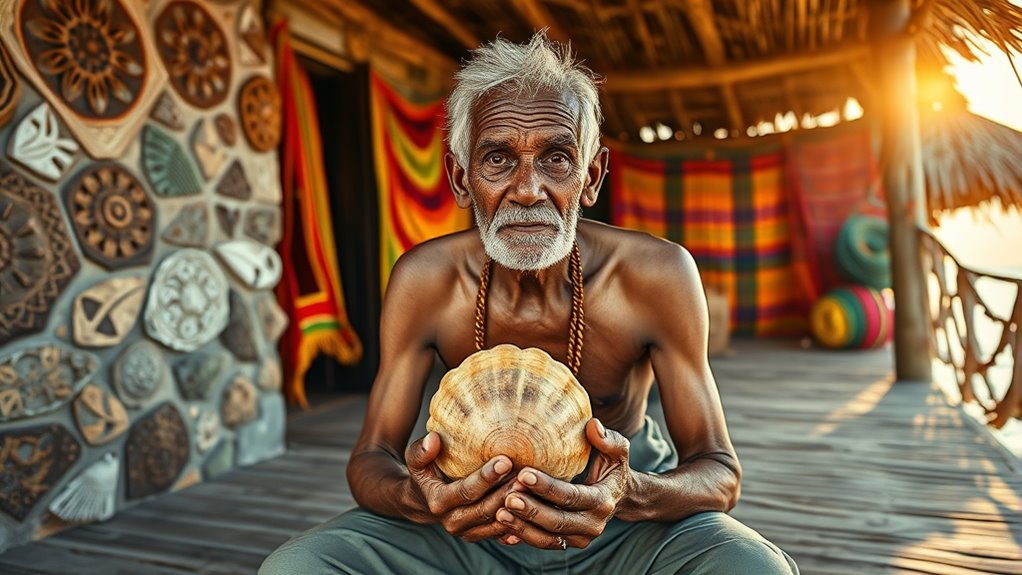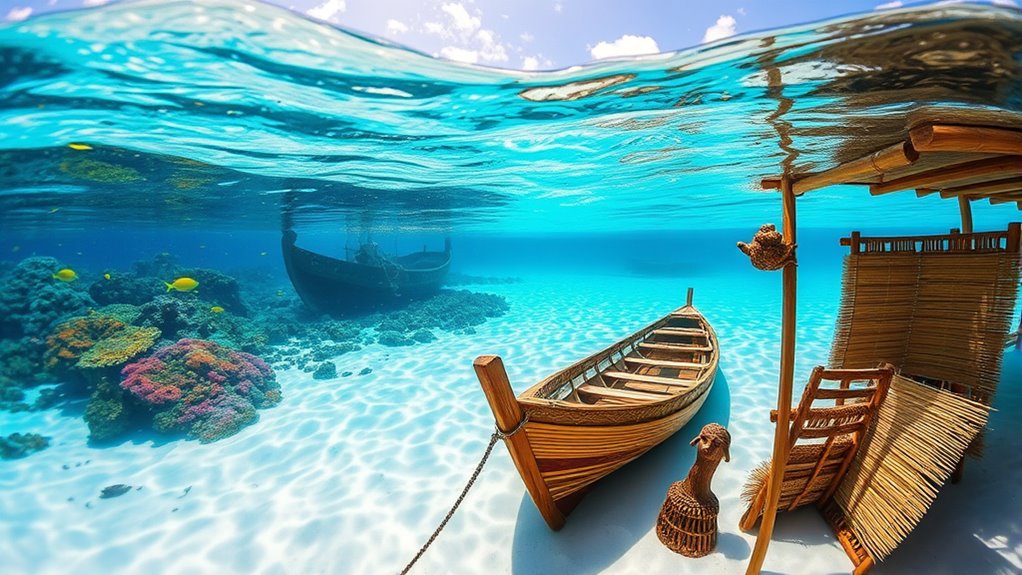Discover the rich history and culture of the Maldives, which dates back over 2,500 years with ancient settlements, coral-stone structures, and trade links spanning Africa, Asia, and Europe. You’ll see how Islamic faith replaced earlier religions, shaping local customs and governance, while dynasties and maritime trade played essential roles in its development. Learn how heritage sites, oral traditions, and modern efforts keep its cultural identity alive as you explore more about this unique nation.
Key Takeaways
- Maldives’ history dates back over 2,500 years, marked by early settlements, coral-stone structures, and ancient inscriptions.
- Transition from Hindu and Buddhist influences to Islamic dominance around 1153 AD significantly shaped national identity.
- The Maldives experienced dynastic rule, colonial influences, and modern political reforms, transitioning from sultanate to republic.
- Historically, Maldives was a vital hub in Indian Ocean trade, exchanging goods like pearls, spices, and fostering cultural exchanges.
- Contemporary Maldivian culture preserves traditional practices, heritage sites, and oral histories amid modernization and tourism development.
Early Human Settlement and Ancient Roots

The Maldives’ early human settlement dates back to around 1500 BCE, likely brought by Aryan immigrants connected to those settling in Sri Lanka. You can see evidence of these early settlers, known as Dheyvis, who probably came from Kalibanga, India, before Emperor Asoka’s reign. Archaeological finds, like copper plates, coral-stone artifacts, and folklore, show the islands have been continuously inhabited for over 2,500 years. The Maldives appears in ancient texts such as the Periplus of the Erythraean Sea and Ptolemy’s Geography, highlighting its importance in trade routes. Early cultural influences include Hinduism, which left behind artifacts predating the arrival of Islam. These roots establish a long history of human presence, seafaring, and cultural development in the Maldives. Additionally, ongoing research into archaeological discoveries continues to shed light on the island nation’s ancient past.
Religious Transformation and Cultural Shifts

Religious transformation in the Maldives marks a significant turning point in its history, shifting from centuries of Hindu and Buddhist influence to Islamic dominance. Around 1153 AD, Islam officially took hold, replacing older faiths and shaping national identity. You’ll notice many Buddhist sites were dismantled, yet some still remain today. This shift influenced laws, customs, and governance, as rulers adopted the title Sultan and aligned with Islamic principles. The change didn’t erase the earlier cultures but integrated them into a new Islamic identity. Here’s a quick overview: cultural integration
Dynastic Rule and Political Evolution

Throughout its history, the Maldives has seen a series of dynasties shaping its political landscape. You witness the rise and fall of rulers from the Maley dynasty, which lasted 235 years, and the Hilali dynasty, ruling for over 170 years. These dynasties established strong sultanates, with rulers claiming divine authority. You see Portuguese occupation from 1558 to 1573, which was driven out by local resistance. Later, the islands became a protectorate under Dutch Ceylon in the 17th century, followed by British control in 1887, influencing governance. In the 20th century, you observe shifts toward democracy, with the 1932 constitution and the abolition of the sultanate. Independence in 1965 marked the start of modern nationhood, shifting from monarchy to republic, shaping the Maldives’ political evolution.
Maritime Trade and International Relations

Your island nation has long been part of extensive trade networks that connected it to Rome, China, and other civilizations. These interactions brought in valuable goods like pearls, spices, and shells, shaping the Maldives’ economy and culture. As you explore its history, you’ll see how diplomatic ties expanded with foreign powers, reinforcing its role as a key maritime hub. Additionally, the Maldives’ strategic location has made it an important maritime trade center throughout history.
Ancient Trade Networks
Did you know that Maldives played a vital role in ancient Indian Ocean trade networks? Its strategic location made it a key hub for maritime commerce connecting Africa, Asia, and the Middle East. Traders from Rome, China, Persia, and Arabia visited the islands to exchange goods like pearls, spices, coconuts, and dried fish. Historical records mention gifts sent to Roman Emperor Julian around 362 AD and tributes to Chinese emperors in 662 AD, highlighting long-standing diplomatic ties. The Maldives served as a crucial stopover for seafarers charting the Indian Ocean, facilitating cultural exchanges and economic interactions. Its natural resources and maritime expertise made it an essential link in ancient trade routes, fostering connections that shaped regional relations and contributed to the islands’ prosperity. Battery technologies played a role in powering navigation tools used by ancient sailors, further supporting maritime activities and trade.
Diplomatic Engagements
Positioned at a strategic crossroads in the Indian Ocean, the Maldives has actively engaged in diplomatic relations to strengthen its trade and political ties over centuries. You’ll see how its location made it a crucial hub for maritime trade, attracting Arab, Persian, Chinese, and European traders. Early diplomatic efforts included gifts to Roman emperors and tribute to Chinese rulers, highlighting its international reach. Over time, Maldives cultivated alliances through trade agreements and diplomatic missions, especially during the 18th and 19th centuries when it became a protectorate under foreign powers. Today, its diplomacy continues through regional cooperation and participation in international organizations. You can observe how the Maldives balances maintaining its sovereignty while leveraging its strategic position to foster economic growth and regional stability. Additionally, Forsale 100 reflects the ongoing importance of strategic trade routes and diplomatic engagement in shaping the Maldives’ international relations.
Heritage Preservation and Oral Traditions

You can see how oral traditions keep Maldivian history alive by passing stories through generations, preserving cultural identity. Archaeological heritage sites, like ancient temples and coral-stone ruins, also serve as tangible links to the past. Together, these methods guarantee that the Maldives’ rich history remains a essential part of its modern culture. Additionally, understanding heritage preservation techniques helps appreciate how these efforts maintain the nation’s historical integrity for future generations.
Oral History Transmission
Oral history plays a vital role in preserving the Maldives’ rich cultural heritage, passing down stories, customs, and traditions from generation to generation. You are part of a living tradition where elders share tales of migration, legendary heroes, and maritime adventures that define Maldivian identity. These stories are often told during community gatherings, festivals, and family occasions, maintaining a deep connection to the past. You might hear legends about the first settlers or the island’s role in ancient trade networks. Songs, poetry, and proverbs also carry historical meanings, reinforcing cultural values. Through this oral transmission, you keep alive the collective memory that shapes Maldivian society, ensuring that history remains vibrant and accessible even without written records. Additionally, oral traditions serve as a vital means of cultural preservation, especially in societies where written documentation is limited.
Archaeological Heritage Sites
Archaeological heritage sites in the Maldives serve as tangible links to the islands’ rich history, preserving remnants of ancient civilizations and cultural practices. These sites include coral-stone structures, Buddhist ruins, and copper inscriptions that reveal early settlements and religious shifts. They highlight the islands’ maritime importance and cultural progressions over centuries. Preservation efforts focus on maintaining these relics amid development, ensuring history endures. The table below illustrates key aspects of heritage sites:
| Site Type | Key Features | Historical Significance |
|---|---|---|
| Buddhist Ruins | Temples, stupas | Proof of early religion and art |
| Coral-Stone Structures | Fortresses, homes | Architectural techniques and living patterns |
| Copper Plates | Inscriptions, records | Documented history and grants |
| Cave Paintings | Ancient engravings | Insights into prehistoric beliefs |
These sites help you connect with Maldives’ ancient past, shaping its identity today. archaeological heritage sites
Modern Nationhood and Cultural Continuity

Since gaining independence in 1965, the Maldives has undergone significant political and social transformations that shaped its modern identity. You witness how the nation shifted from a traditional sultanate to a republic, adopting new constitutions and democratic reforms. Despite these changes, the Maldives maintains deep cultural roots, blending Islamic practices with centuries-old traditions. You see efforts to preserve historical sites, oral histories, and language, ensuring cultural continuity amid modernization. The rise of tourism in the late 20th century transformed the economy, bringing global influence while encouraging cultural resilience. Today, the Maldives balances modern governance with respect for its heritage, fostering a national identity that honors its past while embracing progress. This ongoing journey reflects how the Maldives sustains its unique cultural fabric through change. Additionally, the preservation of cultural traditions remains vital in maintaining the nation’s identity amidst rapid development.
Frequently Asked Questions
What Are the Main Archaeological Sites in the Maldives?
You’ll find main archaeological sites like the Loamaafaanu plates in Malé, which reveal ancient inscriptions and history. On islands like Thulusdhoo and Dhigurah, you can explore coral-stone ruins and Buddhist relics that showcase the islands’ past. Don’t miss the ancient Buddhist stupas and temples scattered across the Maldives, which highlight the rich religious history. These sites help you connect with the islands’ deep cultural and historical roots.
How Did Hinduism Influence Early Maldivian Culture?
You might think Hinduism’s influence on early Maldivian culture is just ancient history, but it’s woven into everything. From intricate art and temple ruins to the islanders’ customs, Hindu traditions left a lasting mark. You’ll find relics, inscriptions, and stories that celebrate this heritage, revealing a time when Hindu cultural practices shaped social structures, art, and spirituality—an ironic reminder of how deeply the past still influences the present.
What Are Some Traditional Maldivian Arts and Crafts?
You’ll find that traditional Maldivian arts and crafts include intricate wood carvings, colorful lacquer work, and woven mats called “thundu kunaa.” Craftsmanship extends to coral stone carvings and jewelry made from shells and pearls. You might also see embroidered fabrics and handmade musical instruments. These crafts reflect the islands’ rich maritime heritage and cultural influences, showcasing your local artisans’ skill and creativity in preserving their unique traditions.
How Has Tourism Impacted Maldives’ Cultural Heritage?
Tourism has considerably influenced Maldives’ cultural heritage by promoting local crafts, music, and dance, but it also risks commercialization and loss of authenticity. You might notice traditional art forms being adapted for tourists, sometimes diluting their cultural significance. While tourism boosts the economy and raises awareness of Maldives’ unique heritage, it’s essential to preserve authentic practices and sites to maintain the true identity of your island culture amid global influences.
Are There Any Remaining Buddhist Monuments Today?
Yes, there are still some remnants of Buddhist monuments in the Maldives. Imagine ancient stone ruins, silent witnesses to a bygone era, scattered across islands like whispers of the past. These relics, such as carved stupas and temples, stand as breathtaking echoes of a rich Buddhist history. While many were dismantled, a few sacred sites remain, offering a glimpse into the island’s ancient spiritual landscape for curious visitors like you.
Conclusion
As you explore the Maldives’ history, imagine it as a graceful dhow sailing through changing tides—each wave representing a chapter of cultural shifts and resilience. The islands, like seasoned sailors, carry stories of ancient roots, religious transformations, and enduring traditions. Their journey shows that even amidst storms of change, the spirit of the Maldives remains steadfast—a timeless voyage where heritage and modernity intertwine, guiding you through a legacy that’s both fragile and beautifully enduring.










